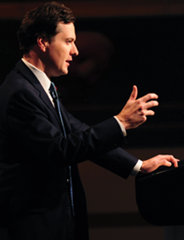UK economy: getting beyond zero
 Despite good news on job creation, a weak economy is adding more political pressure in Westminster. Peter Cheney sums up the current picture.
Despite good news on job creation, a weak economy is adding more political pressure in Westminster. Peter Cheney sums up the current picture.
If Bank of England predictions are correct, the UK is half way through a year of 0 per cent growth. UK GDP fell by 0.7 per cent in Q2 2012, after falls of 0.3 per cent and 0.4 per cent in the previous two quarters. Britain is therefore nearly a year into a double-dip recession, which promises to cause more economic and political turbulence this autumn.
The Coalition Government is itself, almost half way through its term in office and becoming increasingly fractious. The Lords reform dispute and Lord Oakeshott’s criticism of George Osborne illustrate the problem but it goes much deeper.
Tory backbenchers and grassroots activists have questioned Cameron’s ability to win a majority at the next election. Lib Dems, meanwhile, are fearful about their own prospects at the ballot box. Labour is starting to overtake the Conservatives in opinion polls, and all three parties will be keen to re-assert themselves during conference season.
UK unemployment peaked at 2.68 million last autumn (the highest since 1993) but fell to 2.56 million in the three months to June. At 8 per cent, it remains below the EU average (10.4 per cent) and the euro zone’s 11.2 per cent.
“These are positive and encouraging figures demonstrating the strength of our private sector,” Work and Pensions Secretary Iain Duncan Smith said. “Notwithstanding the difficult economic times, it is still creating jobs, the vast majority of which are full-time. Unemployment is falling and the claimant count is down.”
The consumer price index, meanwhile, was 2.6 per cent higher in July 2012 than in July 2011, due to higher air fares and housing costs. The retail price index rose by 3.2 per cent. Inflation, though, has fallen significantly since September 2011, in a similar trend to the major fall in inflation experienced in 2008.
Writing in The Times, CBI Director-General John Cridland called on the Government to release underspends across Whitehall, to raise the level of capital spending. “Private sector solutions underpinned by government,” he commented, “are more likely to be successful” than new government institutions.
The Government’s Funding for Lending scheme, in Cridland’s view, could help SMEs access more capital but he also sought a change in rules on liquidity buffers for banks, to allow high quality covered bonds to be counted as liquid assets.
“The Treasury should also look at tax relief for raising equity, putting it on a par with debt finance,” he stated, estimating an initial cost to the Exchequer of
£160 million per year.
Office for Budget Responsibility forecasts put UK borrowing for 2011-2012 at £125 billion and some economic analysts expect that figure to be £30 billion higher this year. The Treasury has blamed an unexpected rise in borrowing in July (£600 million compared to a £2.8 billion surplus a year previously) on lower than expected corporation tax receipts.
This development appears to strengthen opposition in the Treasury to devolving corporation tax, and therefore letting Stormont and Holyrood cut it even further. However, the drop may also be explained by the leak in the Elgin gas field in the North Sea.





